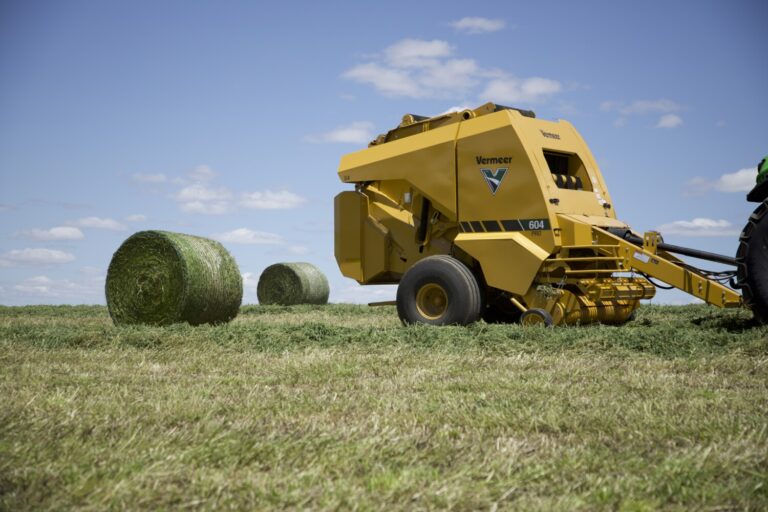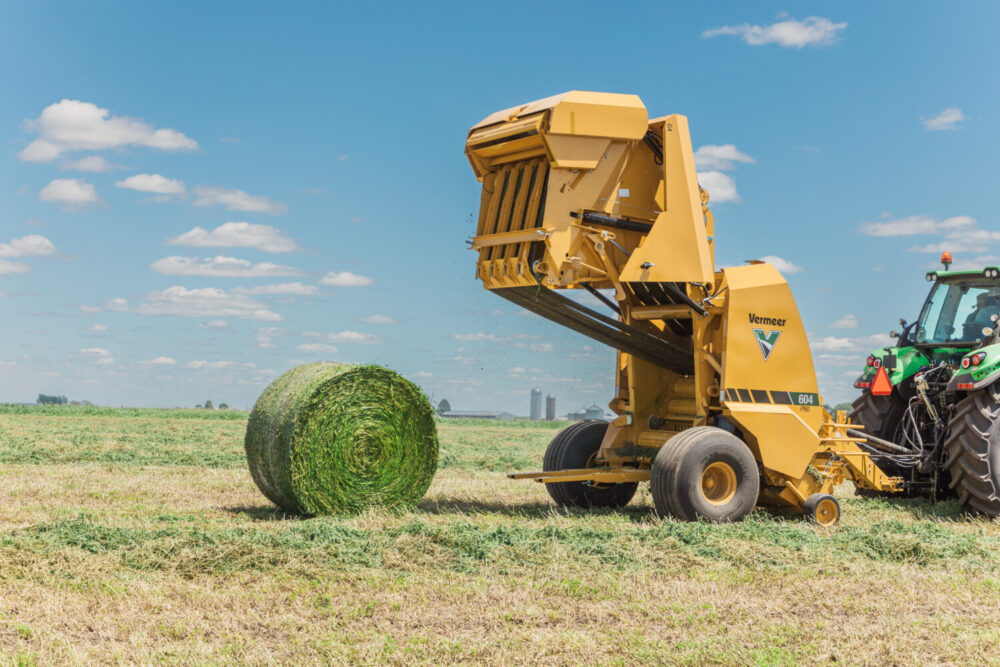
Benefits of Chopped Hay
October 2024
Across the country, agriculturists are on a mission to deliver more product with fewer inputs than ever before. This idea affects the whole industry, whether you’re looking to increase crop yields or more efficiently feed your livestock — and the hay business is not immune.
Chopped hay is just one tool producers use to work toward that goal. Chopper balers can put up silage or dry hay and yield more tons of nutrition per bale with better feed digestibility.
“With pre-chopped material, you’re reducing the particle size, so you’re opening that stem up for additional places for the bacteria to attach and to ferment,” said Mike Brouk, a dairy nutritionist with Kansas State University. “The big advantage here is you get more density, so you exclude more of the oxygen with the chopped hay.”

Putting up chopped hay
To get this increase in nutrition may sound like an increase in time, but fortunately for hay producers, that’s not the case. Brouk said recent studies have shown the pounds of dry matter baled in chopped hay had significantly higher value than traditional hay. In other words, using the chopper baler increased the density of the bale and resulted in an increase in efficiency.
Vermeer Forage Product Engineer Spencer Fynaardt can attest to this. He said customers using a chopper baler equipped for silage also experience more flexibility than those taking the traditional dry hay approach.
“People get sick of waiting on the weather to put up hay,” he said. “They have such a small window and when rain is coming, you really need to just go and put your hay up. Switching to this silage baler allows you to have a smaller weather window of just a couple days, or even a day, to get all your hay wrapped and protected from the weather rather than having to wait.”
Maximizing nutrition
For Jared Boyert’s cattle business, the efficiency perks don’t end in the hay field. By using chopped hay, he is eliminating the need for a grinder or hiring a third party to grind hay for his feed ration.
“We are saving fuel money on mixing cost, saving netwrap cost on fewer bales, saving land for storage, and the list goes on,” he said. “We won’t ever bale without a chopping system now that we’ve had one.”
The common adage, “time is money” applies for Boyert, as well. By using chopped hay in his total mixed ration, he has seen a decrease in mixing time. For him, that means more time for him to focus on other tasks around the farm — he isn’t complaining about the decrease in fuel for running the mixer less either.
Brouk echoes this sentiment, and he said chopping hay ahead of time with a chopper baler ultimately reduces waste from the whole system from the field to the livestock — especially if you grow your herd over time. As the herd grows, the investment in the chopper baler will then be spread across more head of livestock, making it more economical.
Regardless if you’re feeding five head or 500 head, all ruminant animals require fiber to stimulate ruminations, according to Brouk. This fiber source may look different for different types of operations depending on their access to feedstuffs, but the goal is the same — improve palatability and increase nutrition with less feed.
Since he introduced chopped hay to his herd, Boyert has seen their consumption improve, resulting in less waste and more performance as the cattle mature.

“Cows just love it,” Fynaardt added. “Your feed quality is better with silage, your palatability is better and the cows like it more. Those are some big benefits of it.”
An investment that pays off
All of this leads to fewer steps in the process and helps minimize waste — a win for producers, Brouk said. While a chopper baler is a large investment some small producers may struggle to justify, there are options to make it work to help benefit your bottom line and your herd’s productivity.
“There is a possibility that a custom baler in a local area could help several smaller producers,” he said. “Two or three people go together and purchase a baler in common, and then share it amongst their operations to divide that ownership cost over a greater number of animals.”
For Boyert, the investment in a chopper baler was a no-brainer after experiencing the benefits firsthand.
“In previous years before buying our own baler, we had bought hay from other local producers,” he said. “Some of that hay was precut. Those precut bales quickly became our favorites for many reasons, so when it came time to buy our own baler, we knew we wanted one with a chopper system.”
To walk through the value in chopped hay and how to select the right equipment for the job, contact your local Vermeer dealer today.
Information noted above was gathered from a third party who was advised his/her experience might be featured in marketing materials. This article contains third-party observations, advice or experiences that do not necessarily reflect the opinions of Vermeer Corporation, its affiliates or its dealers. Individual results may vary based on care and operation of machine and crop and field conditions, which may adversely affect performance.
Vermeer Corporation reserves the right to make changes in engineering, design and specifications; add improvements; or discontinue manufacturing at any time without notice or obligation.
Equipment shown is for illustrative purposes only and may display optional accessories or components specific to their global region.
Please contact your local Vermeer dealer for more information on machine specifications.
Vermeer, the Vermeer logo and the Black, White, Green bale wrap color scheme (Vermeer Net) are trademarks of Vermeer Manufacturing Company in the U.S. and/or other countries.
© 2024 Vermeer Corporation. All Rights Reserved.
